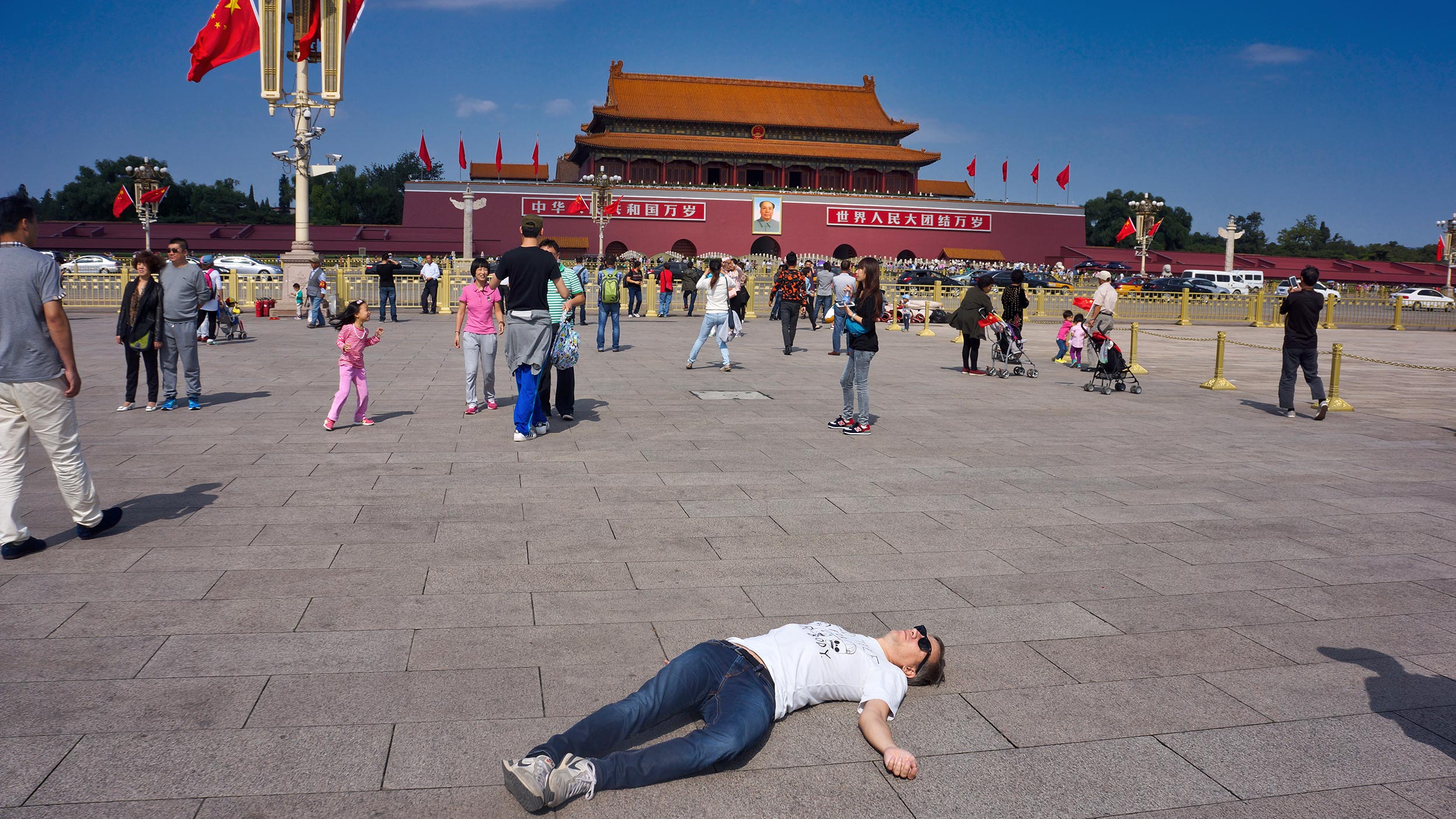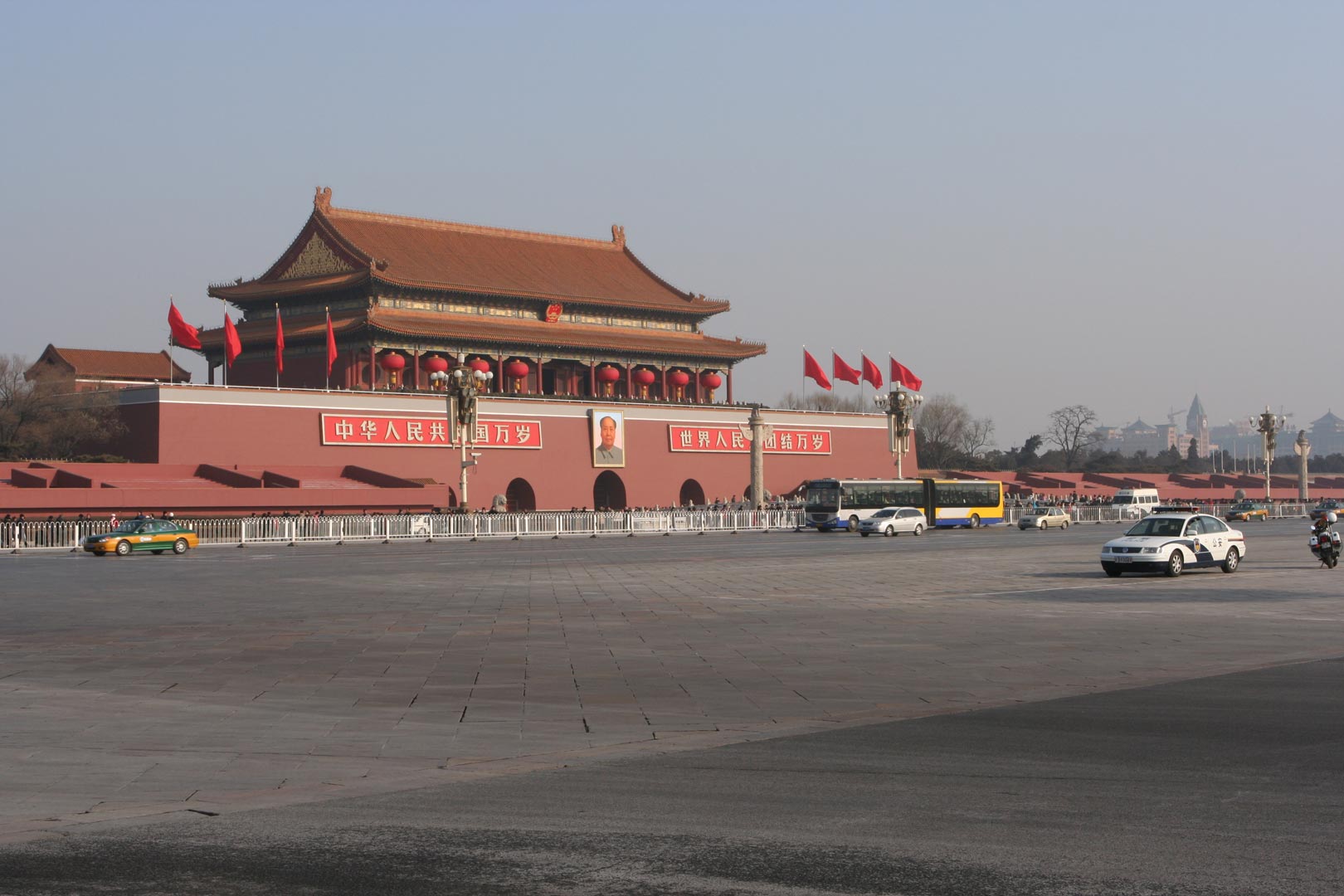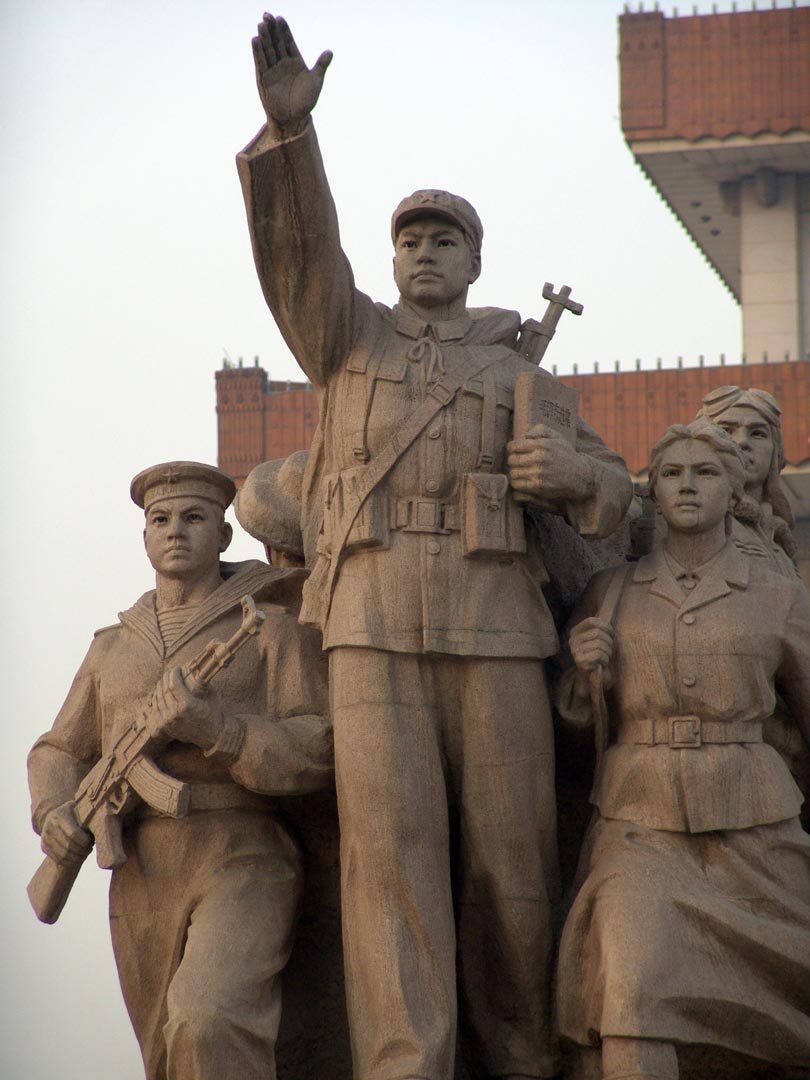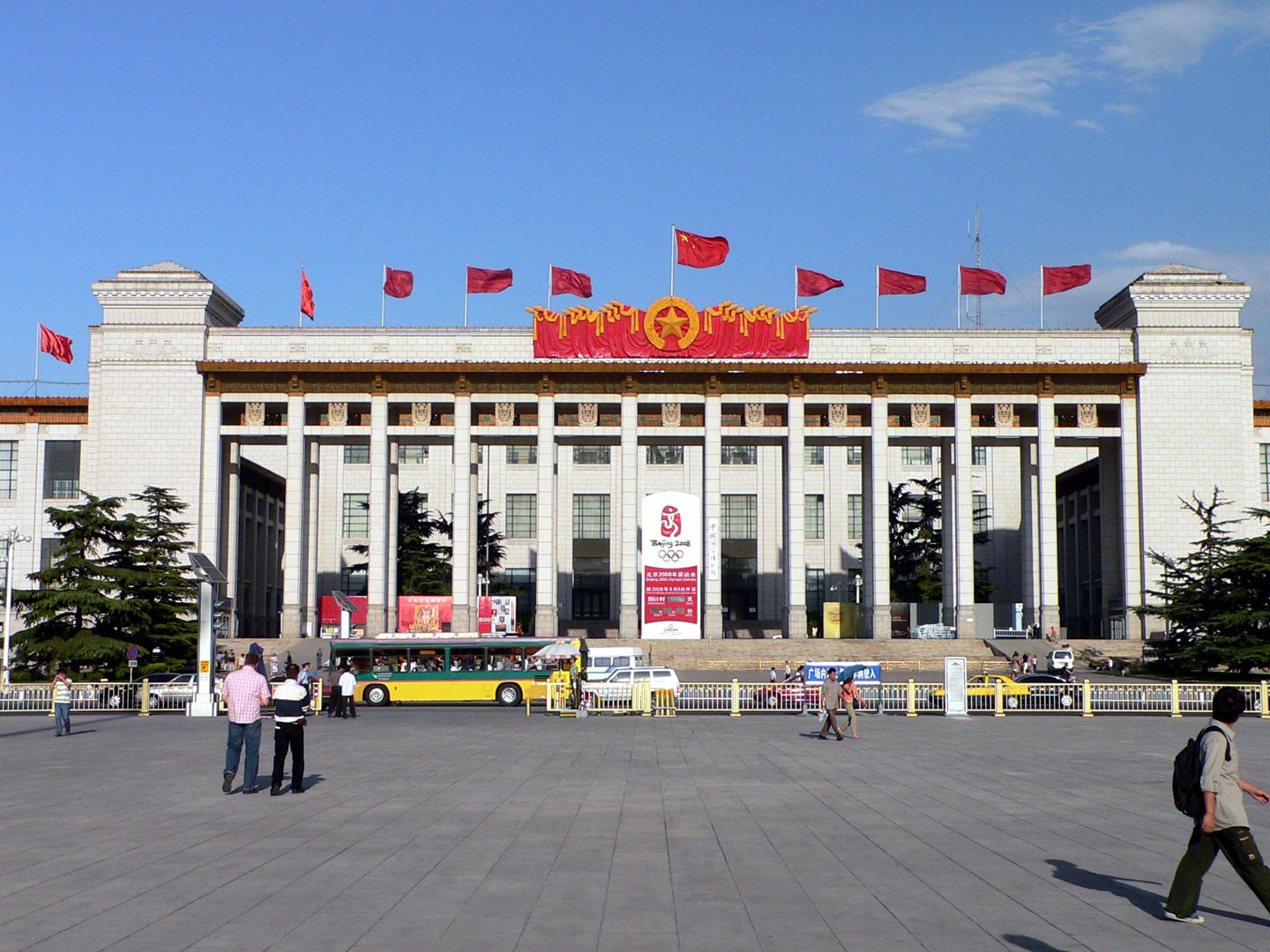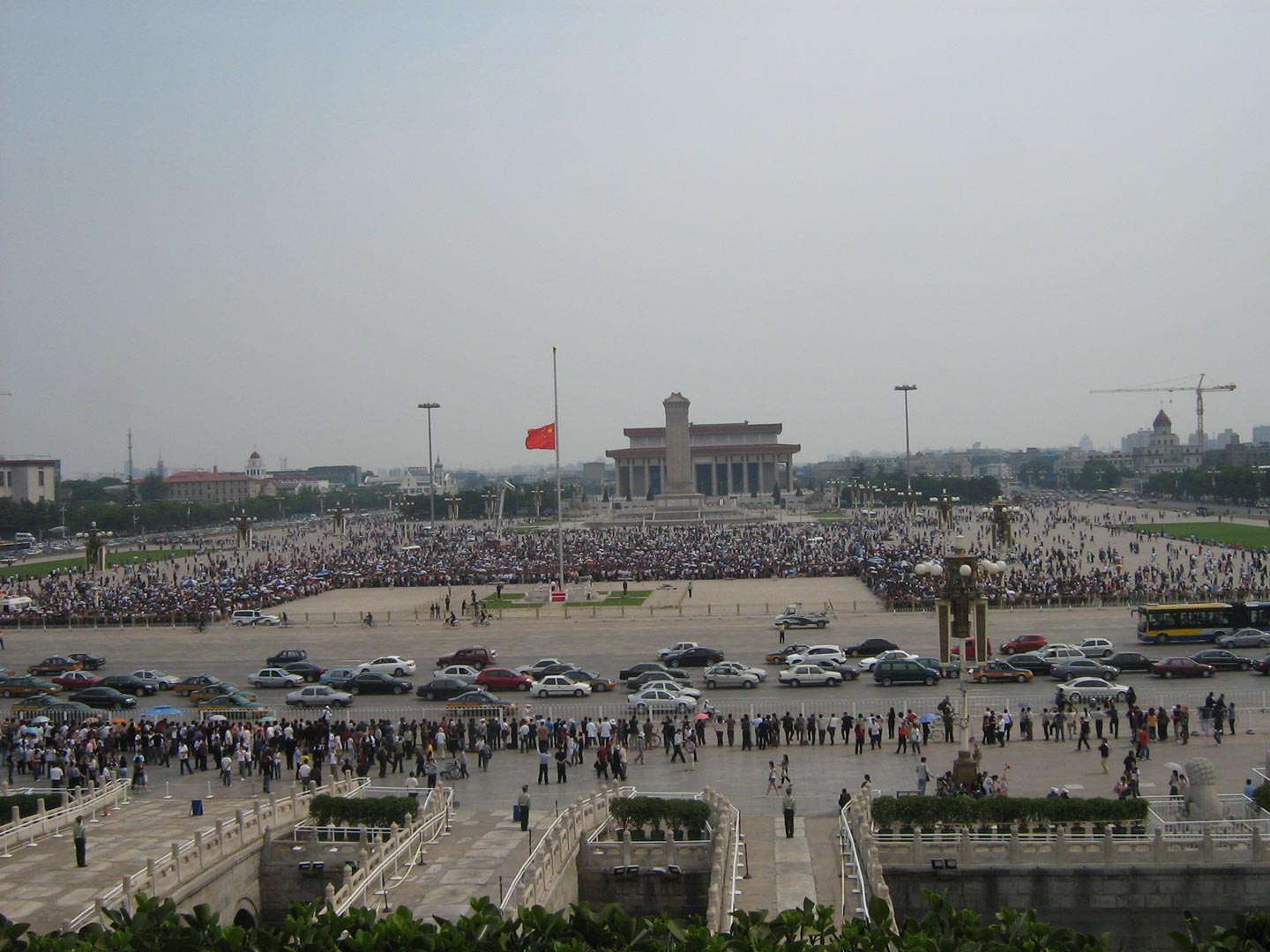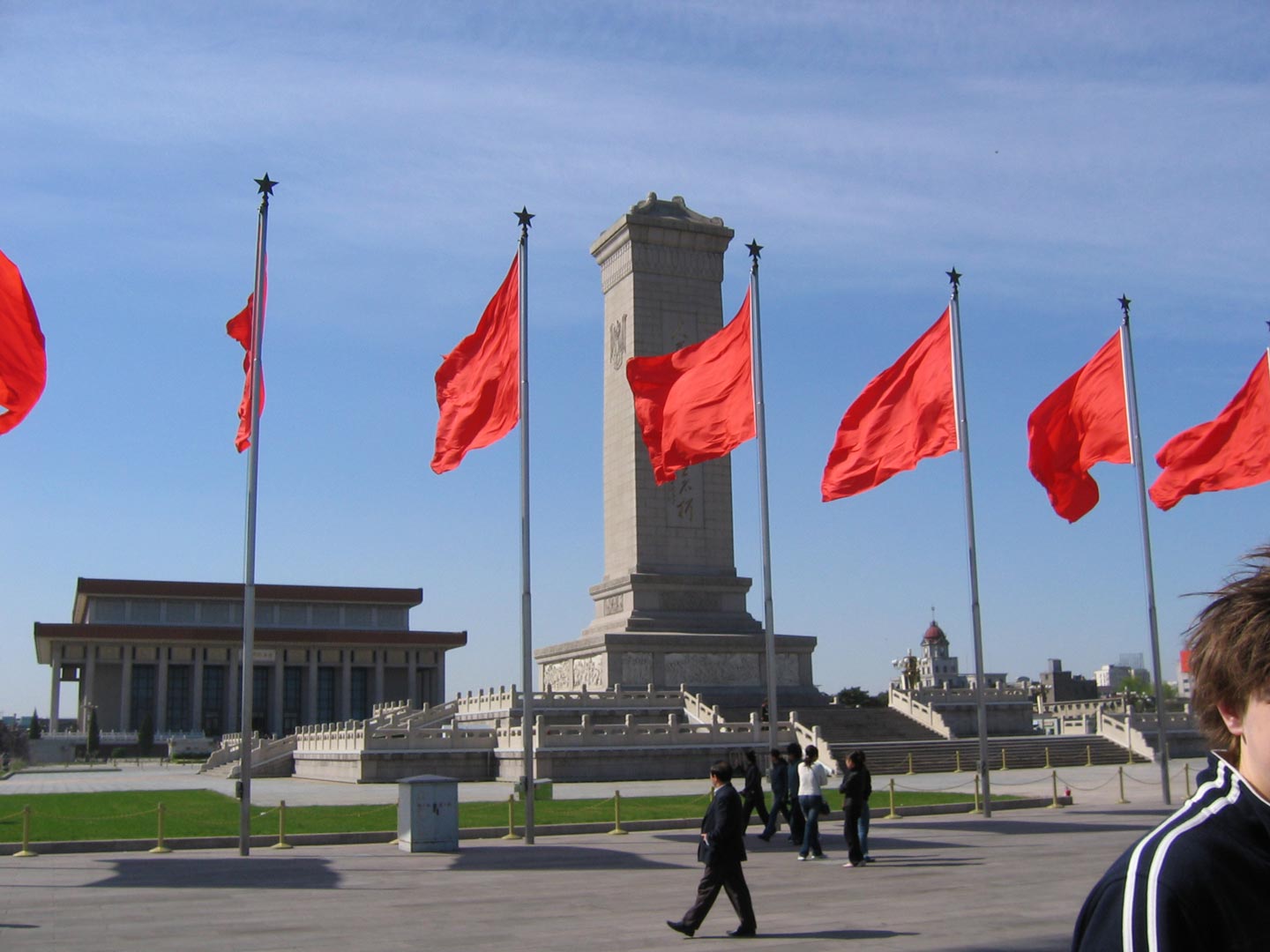Tiananmen Square
Tiananmen Square or Tian'anmen Square (天安門, Pinyin: Tiān'ānmén) is a city square in the centre of Beijing, China, named after the Tiananmen ('Gate of Heavenly Peace') located to its north, separating it from the Forbidden City. The square contains the Monument to the People's Heroes, the Great Hall of the People, the National Museum of China, and the Mausoleum of Mao Zedong. Mao Zedong proclaimed the founding of the People's Republic of China in the square on October 1, 1949; the anniversary of this event is still observed there.
“Tiananmen Square is within the top ten largest city squares in the world (440,500 m2 – 880×500 m or 109 acres – 960×550 yd) It has great cultural significance as it was the site of several important events in Chinese history.”
History
The Tiananmen ("Gate of Heavenly Peace"), a gate in the wall of the Imperial City, was built in 1415 during the Ming dynasty. In the 17th century, fighting between Li Zicheng's rebel forces and the forces of the Manchu-led Qing dynasty caused heavy damage to, or even destroyed, the gate. Tiananmen Square was designed and built in 1651, and has since been enlarged by four times its original size in the 1950s.
Near the centre of the square stood the "Great Ming Gate", the southern gate to the Imperial City, renamed "Great Qing Gate" during the Qing dynasty, and "Gate of China" during the Republican era. Unlike the other gates in Beijing, such as the Tiananmen and the Zhengyangmen, this was a purely ceremonial gateway, with three arches but no ramparts, similar in style to the ceremonial gateways found in the Ming tombs. This gate had a special status as the "Gate of the Nation", as can be seen from its successive names. It normally remained closed, except when the Emperor passed through. Commoner traffic was diverted to side gates at the western and eastern ends of the square, respectively. Because of this diversion in traffic, a busy marketplace, called "Chess Grid Streets", was developed in the big, fenced square to the south of this gate.
In 1860, during the Second Opium War, when British and French troops invaded Beijing, they pitched camp near the gate and briefly considered burning down the gate and the entire Forbidden City. They decided ultimately to spare the Forbidden City and instead burn down the Old Summer Palace. The Xianfeng Emperor eventually agreed to let the foreign powers barrack troops – and later establish diplomatic missions – in the area, hence there was the Legation Quarter immediately to the east of the square. When the forces of the Eight-Nation Alliance besieged Beijing during the Boxer Rebellion in 1900, they badly damaged the office complexes and burnt down several ministries. After the Boxer Rebellion ended, the area became a space for the foreign powers to assemble their military forces.
In 1954, the Gate of China was demolished, allowing for the enlargement of the square. In November 1958, a major expansion of Tiananmen Square started, which was completed after only 11 months, in August 1959. This followed the vision of Mao Zedong to make the square the largest and most spectacular in the world, and intended to hold over 500,000 people. In that process, a large number of residential buildings and other structures have been demolished. On its southern edge, the Monument to the People's Heroes has been erected. Concomitantly, as part of the Ten Great Buildings constructed between 1958 and 1959 to commemorate the ten-year anniversary of the People's Republic of China, the Great Hall of the People and the Revolutionary History Museum (now the National Museum of China) were erected on the western and eastern sides of the square.
For the first decade of the PRC, each National Day (October 1) was marked by a large military parade in Tiananmen Square, in conscious emulation of the annual Soviet celebrations of the Bolshevik Revolution.
After the disaster of the Great Leap Forward, the CCP decided to cut costs and have only smaller annual National Day celebrations in addition to a large celebration with a military parade every 10 years. However, the chaos of the Cultural Revolution prevented such an event from taking place on National Day, 1969. Ten years later, in 1979, the CCP again decided against a large scale celebration, coming at a time when Deng Xiaoping was still consolidating power and China had suffered a rebuff in a border war with Vietnam early in the year. By 1984, with the situation much improved and stabilized, the PRC held a military parade for the first time since 1959. The aftermath of the Tiananmen Square massacre prevented any such activities in October 1989, but military parades have been held in 1999 and 2009, on the 50th and 60th anniversaries of the PRC's founding. On May 8, 2015, a military parade was also held to celebrate the 70th anniversary of the end of World War II.
In 1971, large portraits of Karl Marx, Friedrich Engels, Vladimir Lenin, Joseph Stalin, Sun Yat-sen, and Mao Zedong were erected in the square, painted by artist Ge Xiaoguang, who is also responsible for producing the famous portrait of Mao that hangs over the Gate of Heavenly Peace. In 1980, with the downgrading of political ideology following Mao's death, the portraits were taken down and thenceforth only brought out on Labor Day (May 1) and National Day. In 1988, the CCP leadership decided to display only the portraits of Sun and Mao on national holidays.
The year after Mao's death in 1976, a mausoleum was built near the site of the former Gate of China, on the main north-south axis of the square. In connection with this project, the square was further increased in size to become fully rectangular and being able to accommodate 600,000 people.[8]
The urban context of the square was altered in the 1990s with the construction of National Grand Theatre in its vicinity and the expansion of the National Museum
1989 Tiananmen Square protests
The Tiananmen Square protests, commonly known in mainland China as the June Fourth Incident (Chinese: 六四事件, liùsì shìjiàn), were student-led demonstrations held in Tiananmen Square in Beijing during 1989. The popular national movement inspired by the Beijing protests is sometimes called the '89 Democracy Movement (Chinese: 八九民运, bājiǔ mínyùn). The protests started on 15 April and were forcibly suppressed on 4 June when the government declared martial law and sent the military to occupy central parts of Beijing. In what became known as the Tiananmen Square Massacre, troops with assault rifles and tanks fired at the demonstrators and those trying to block the military's advance into Tiananmen Square. Estimates of the death toll vary from several hundreds to several thousands, with thousands more wounded.
Set off by the death of pro-reform Communist leader Hu Yaobang in April 1989, amid the backdrop of rapid economic development and social changes in post-Mao China, the protests reflected anxieties about the country's future in the popular consciousness and among the political elite. The reforms of the 1980s had led to a nascent market economy which benefited some people but seriously disaffected others, and the one-party political system also faced a challenge of legitimacy. Common grievances at the time included inflation, corruption, limited preparedness of graduates for the new economy, and restrictions on political participation. The students called for democracy, greater accountability, freedom of the press, and freedom of speech, although they were highly disorganized and their goals varied. At the height of the protests, about 1 million people assembled in the Square.
As the protests developed, the authorities responded with both conciliatory and hardline tactics, exposing deep divisions within the party leadership.[By May, a student-led hunger strike galvanized support for the demonstrators around the country, and the protests spread to some 400 cities. Ultimately, China's paramount leader Deng Xiaoping and other Communist Party elders believed the protests to be a political threat and resolved to use force. The State Council declared martial law on May 20 and mobilized as many as 300,000 troops to Beijing. The troops advanced into central parts of Beijing on the city's major thoroughfares in the early morning hours of June 4, killing both demonstrators and bystanders in the process.
The international community, human rights organizations, and political analysts condemned the Chinese government for the massacre. Western countries imposed arms embargoes on China.[16] The Chinese government made widespread arrests of protesters and their supporters, suppressed other protests around China, expelled foreign journalists, strictly controlled coverage of the events in the domestic press, strengthened the police and internal security forces, and demoted or purged officials it deemed sympathetic to the protests. More broadly, the suppression halted the policies of liberalization in the 1980s. Considered a watershed event, the protests set the limits on political expression in China up to the present day. Its memory is widely associated with questioning the legitimacy of Communist Party rule and remains one of the most sensitive and most widely censored topics in China.
Date: October 2014
Photographer: Bruno Sellés
Additional information: wikipedia
